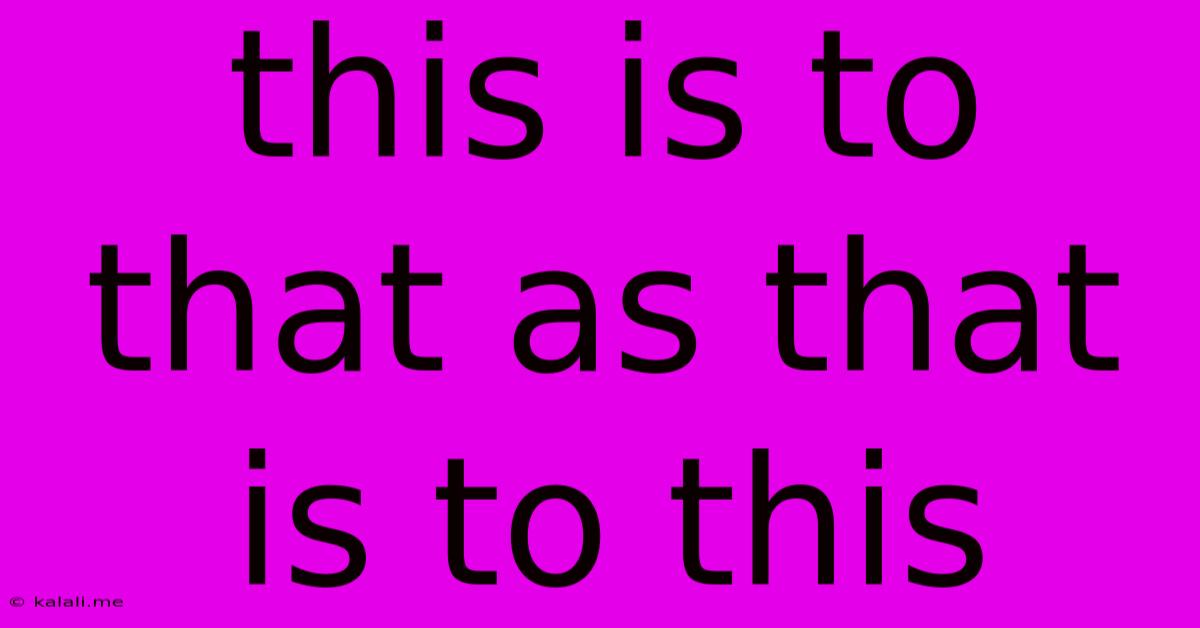This Is To That As That Is To This
Kalali
May 23, 2025 · 3 min read

Table of Contents
This Is To That As That Is To This: Understanding Analogies and Their Power
This seemingly simple phrase, "this is to that as that is to this," hints at the profound power of analogies. Analogies are fundamental to how we understand the world, learn new concepts, and communicate complex ideas. This article explores what analogies are, how they work, their different types, and their crucial role in various fields, including writing, problem-solving, and education. Understanding analogies will not only enhance your communication skills but also strengthen your critical thinking abilities.
What is an Analogy?
An analogy is a comparison between two things, typically for the purpose of explanation or clarification. It establishes a relationship between two seemingly dissimilar concepts by highlighting their shared similarities. The core idea is to illuminate the less familiar concept using the more familiar one as a bridge. The structure often follows the pattern: "A is to B as C is to D," where the relationship between A and B mirrors the relationship between C and D. This mirrors the title phrase, showcasing the reciprocal nature sometimes found in analogies.
Types of Analogies
Several types of analogies exist, each serving a unique purpose:
- Simple Analogies: These are straightforward comparisons that highlight a single shared characteristic. For example, "The sun is to the day as the moon is to the night."
- Extended Analogies: These draw parallels across multiple aspects of two different concepts, often spanning several sentences or even paragraphs. They are used to build a comprehensive understanding of a complex idea.
- Metaphors and Similes: Metaphors directly state that one thing is another (e.g., "The world is a stage"), while similes use "like" or "as" to compare two things (e.g., "He was as brave as a lion"). Both are types of analogies, albeit more stylistic in nature.
- Proportional Analogies: These focus on the mathematical relationship between the elements. "A is to B as C is to D" here implies a proportional relationship – for instance, "2 is to 4 as 3 is to 6."
The Power of Analogies: Why They Matter
Analogies possess considerable power for several reasons:
- Improved Understanding: They simplify complex information, making it accessible and easier to grasp, especially for new concepts or abstract ideas.
- Enhanced Memory: The comparison process aids in memory retention, as we link new information to pre-existing knowledge.
- Problem-Solving: Analogies facilitate problem-solving by allowing us to approach a challenge from a different perspective, drawing insights from a similar situation in a different domain. For example, understanding the flow of electricity might be easier by drawing parallels to the flow of water.
- Effective Communication: They make communication more engaging and memorable, as they connect with the audience on a more intuitive level.
Using Analogies Effectively
Crafting powerful analogies requires careful consideration:
- Choose Familiar Concepts: Select a comparison that your audience is already familiar with.
- Highlight Relevant Similarities: Focus on the crucial aspects that establish a meaningful link between the two concepts.
- Avoid Oversimplification: While simplifying is crucial, be mindful of avoiding oversimplification to the point of inaccuracy.
- Context is Key: The effectiveness of an analogy depends heavily on the context in which it's used.
In conclusion, "this is to that as that is to this" encapsulates the essence of analogies – a powerful tool for understanding, learning, and communication. By mastering the art of using analogies effectively, you can enhance your cognitive skills, strengthen your communication, and achieve a deeper understanding of the world around you.
Latest Posts
Latest Posts
-
If Now Sysdate Sleep 15 0
May 23, 2025
-
How Many Times Were The Israelites Enslaved
May 23, 2025
-
Can You Use With The Name
May 23, 2025
-
Wil Latex Primer Last On Pressure Treated Plywood
May 23, 2025
-
How To Get To Kala E Bay
May 23, 2025
Related Post
Thank you for visiting our website which covers about This Is To That As That Is To This . We hope the information provided has been useful to you. Feel free to contact us if you have any questions or need further assistance. See you next time and don't miss to bookmark.